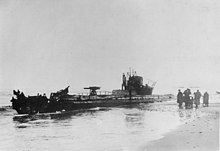SM U 20
|
|
|
|---|---|
|
SM U 20 ( previous / next - all submarines ) |
|
|
SM U 20 front left in the Kiel submarine harbor , 1914 |
|
| Type: | |
| Shipyard: | |
| Launch: |
December 18, 1912 |
| Commissioning: |
August 5, 1913 |
| Calls: |
29 patrols |
| Sinkings: |
36 ships with a total tonnage of 144,300 GRT |
| Whereabouts: | Accumulated off the Danish coast on November 4, 1916. Blown up by the crew the next day. |
SM U 20 was a submarine of the Imperial Navy . Together with the structurally identical boats U 19 , U 21 and U 22 , it was commissioned on November 25, 1910 from the Imperial Shipyard Danzig . The boat became known through the sinking of the British passenger steamer RMS Lusitania of the Cunard Line on May 7, 1915.
Emergency trips
In the first months of the war, U 20 made eight patrols under the leadership of Kapitänleutnant Dröscher before Kapitänleutnant Walther Schwieger took over this boat on December 16, 1914. On April 30, 1915, it ran from its base in Emden on its 15th patrol . The order issued by the FdU (leader of the submarines) on April 25th read:
“Great British troop transports to be expected, starting from Liverpool , Bristol Channel , Dartmouth . The U 20 and U 27 should be dispatched as soon as possible to damage these transports. Go to stations around Scotland as quickly as possible , pause as long as supplies allow. Boats are supposed to attack: vans, merchant ships, warships. "
On May 5, 1915, U 20 had reached the south coast of Ireland. In the next two days it sank a sailor ( Earl of Lathom , 132 GRT) and two freighters ( Candidate , 5858 GRT, and Centurion , 5945 GRT) there. On the morning of May 7th, Kapitänleutnant Schwieger decided to march back because of the thick fog. Around 11:00 a.m. (German time) it cleared up and U 20s were forced to dive by a guard. Then a British cruiser of the Eclipse class , the HMS Juno , ran over the boat, which disappeared in the direction of Queenstown . At 1:45 p.m., Schwieger reappeared.
At 2:20 p.m. four chimneys and two masts were seen ahead. A little later a large passenger steamer was spotted heading towards Galley Head . At 14:35, the steamer - it was the Lusitania - changed course to starboard and set course for Queenstown. At 3:10 p.m. U 20 fired a torpedo from a distance of approx. 700 meters, which hit the steamer on the starboard side, at the level of the navigating bridge. Immediately afterwards there was a second explosion. The Lusitania sank after only 18 minutes, a few nautical miles from Cape Old Head of Kinsale on the south-east coast of Ireland . A total of 1198 people were killed. Among them were 128 American citizens.
The charge was made that the German commander acted contrary to international law by sinking the Lusitania ; he not only attacked a defenseless passenger ship, but also shot a second torpedo on the sinking ship. According to his own statement, Schwieger shot only one torpedo. The second explosion was possibly caused by ammunition, coal, aluminum dust or the like. triggered. The Lusitania reportedly did not fly a flag and had a large load of ammunition on board.
In advance, the imperial embassy in Washington had warned in all major American newspapers against embarking on a transatlantic voyage, since the combat zone also included the sea around the British Isles.
Historians have also speculated whether the United States used the sinking of the Lusitania to join Great Britain in the First World War.
After U 20 returned from this 15th operation on May 13, 1915, it carried out further missions in the following period. On November 4, 1916, the U 20 was on its way home from its 29th mission. As a result of a current transfer and thick fog, it ran aground at Horns Reef off the Danish coast, five nautical miles north of Bovbjerg . All rescue attempts failed. The boat was blown up the next day. Finds from the wreck are part of an exhibition in the Strandingsmuseum St. George Thorsminde in Denmark.
Countersinks (selection)
U 20 sank a total of 36 ships with 144,300 GRT.
- British schooner Earl of Lathom (132 GRT), sunk on May 5, 1915
- British steamer Centurion (5945 BRT), sunk on May 6, 1915
- British steamer Candidate (5858 GRT), sunk on May 6, 1915
- British passenger steamer RMS Lusitania (30,396 GRT), sunk on May 7, 1915 (1198 dead)
- Anglo-Californian horse transporter (7333 GRT), shot at together with U 38 on July 4, 1915 (21 dead)
- British passenger steamer RMS Hesperian (10,920 GRT), sunk on September 4, 1915 (32 dead)
- British passenger steamer Cymric (13,370 GRT), sunk on May 8, 1916 (5 dead)
Individual evidence
- ↑ The SM stands for His Majesty and refers to the then ruling German Kaiser Wilhelm II. It reads completely: His Majesty's U-boat , for surface units His Majesty's ship - SMS for short .
- ^ Illustration of a warning from the German legation
See also
literature
- Bodo Herzog, Günter Schomaekers: Knights of the deep, gray wolves. The most successful submarine commanders in the world. 2nd expanded, supplemented and corrected edition. Verlag Welsermühl, Wels et al. 1976, ISBN 3-85339-136-2 .
- Paul Kemp: The German and Austrian submarine losses in both world wars. Urbes-Verlag Hans Jürgen Hansen, Graefelfing before Munich 1998, ISBN 3-924896-43-7 .

